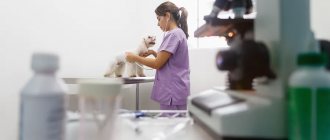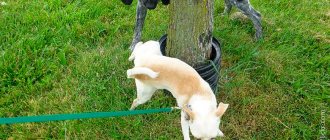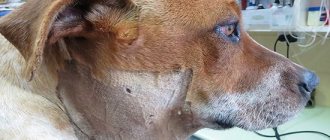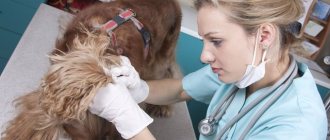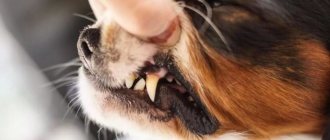Itching in a dog is an unpleasant phenomenon, accompanied by severe scratching. It is not an independent disease, but only acts as a symptom, warning about the danger. If your pet constantly scratches its body, then without timely help it will tear off its skin. Numerous injuries will lead to secondary infection and aggravate the existing problem.
How does itching appear in dogs?
It's quite easy to suspect something is wrong. The dog constantly itches and chews itself in a certain area or throughout the body. Due to unpleasant sensations, she sleeps poorly and refuses games and favorite treats. Appetite decreases, which quickly affects weight. The hair gradually falls out until some areas become completely bald. The skin becomes red and inflamed.
The probable cause of itching in a dog can be determined by its location. Active scratching of the ears indicates a high probability of otodectosis. If your pet rubs all parts of its body against furniture and rolls around on the floor, it may suffer from a skin disease or an allergic reaction. Regardless of the cause, treatment is carried out only after diagnosis in a veterinary clinic.
Allergy
An allergy is an atypical, increased for some reason, reaction of the body to chemical elements of food or the environment, including natural secretions of other animals or people. Normally, any foreign substance that enters a dog’s body is not attacked by the immune system, but is bound and eliminated naturally. If immunoreactivity to a certain substance is increased, an allergic reaction occurs.
Main allergy symptoms:
- Itching of the skin, leading to swelling and scratching.
- Swelling of the mucous membranes. leading to watery eyes, nasal discharge, and increased saliva.
- Sneezing due to nasal discharge and itching in the sinuses.
- Constant “splashing” as a sign that the dog has a sore throat.
- Other reactions include swelling of the eyelids, lips, throat, hair loss, increase or decrease in temperature.
Diagnosis and identification of the cause
Using medications before diagnosis can distort test results. Veterinarians recommend avoiding self-medication and seeking help immediately after an alarming symptom appears.
After a visual examination and history taking, the veterinarian performs the following diagnostic tests:
- stool and urine analysis;
- clinical and blood biochemistry;
- skin scraping, as well as scraping of secretions from the affected areas;
- allergy tests;
- Ultrasound and X-ray.
If there are symptoms of a fungal infection and negative results of basic tests, additional tests may be required. The most popular diagnostic method for this disease is the Wood's lamp.
Clinical picture
On the affected areas of the paws, there is most often a papular-pustular rash (small red pimples and pustules), erythema (redness) of the skin, peeling, there may be small scratches and hairless areas. Sometimes single or multiple “nodules” can form in the interdigital space - dense painful formations, which after some time open with the release of pus. Lesions can occur on one limb or on several at once. The skin of the interdigital spaces may be affected both from the side of the pads and from the opposite side.
Parasitoses
Most often, itching in a dog occurs when infected with external parasites. This is due to lack of timely processing.
Fleas
Flea infestations cause an allergic reaction to the parasites' saliva. It contains a foreign protein that is rejected by the body of an infected animal. If there is a severe infestation of blood-sucking insects, you can notice them yourself. They look like small black or brown grains.
Despite the species classification based on the final host, fleas quickly adapt and can feed on the blood of any animal, including humans. The most dangerous species is the rat. These parasites are more likely than others to carry dangerous infections. A bitten dog can become infected with rickettsiosis, helminthiasis, endocarditis and other diseases.
Ticks
It is possible to find out why a dog itches if it does not have fleas by observing the accompanying symptoms. Tick-borne infestations are characterized by yellowing and severe peeling of the skin, as well as the formation of purulent inflammations. With otodectosis, dark brown discharge forms in the ears, and the sick pet constantly shakes its head.
Infection with subcutaneous mites is fraught with problems with the lymph nodes, kidneys, stomach, spleen and liver. Due to numerous wounds, the risk of death from sepsis increases. Once a secondary infection occurs, the chance of recovery is only 50%.
Like fleas, ticks carry infections. An infected person may suffer from hepatozoonosis, ehrlichiosis, bartonellosis or piroplasmosis.
lice eaters
Lice eaters are the closest relatives of lice, resembling white grains of dandruff and characterized by a quadrangular head shape. They feed on particles of fur and skin, causing severe itching in the dog. Most often, the symptom of infection occurs at the base of the tail, ears, belly or thighs. The affected skin becomes rough and thickened. The condition of the coat is deteriorating. Bald patches form.
Puppies can become infected from a sick mother. In addition to the listed symptoms, the presence of lice in young animals can lead to developmental delays. Also, these parasites often carry helminth eggs, which is especially dangerous for pets under 1 year of age.
Additional Research
To understand why a dog scratches its paws, the doctor must not only carefully examine the dog and interview the owner, but also conduct a number of additional studies.
So, the doctor must take fingerprint smears from the skin to understand whether there is a secondary inflammation and what it is associated with (bacteria or fungi).
Multiple scrapings (diagnosis of demodicosis, sarcaptosis) and hair plucking (diagnosis of demodicosis in the interdigital spaces) should also be performed to confirm or exclude parasites. It is important to remember that if the doctor does not find sarcoptes scabies mites in the scrapings, but the dog’s symptoms are similar to this disease, then treatment for this parasite will definitely be prescribed!
In addition, a surgeon may be invited to the appointment to assess the functionality of the dog’s musculoskeletal system.
Skin diseases
Owners often do not understand what to do if the dog is itchy all the time, but it does not have fleas or other parasites. The fact is that parasitosis is only one of the possible causes. The symptom may also occur due to allergies, exposure to high or low temperatures, fungal or bacterial infections, or malfunction of the exocrine glands.
Allergy
Increased sensitivity to certain irritants causes the dog to experience itching, peeling of the paw pads and redness of the interdigital area. Watery discharge appears from the eyes and nose, and swelling and rash appear on the skin. Diarrhea and excessive sweating may occur, which can be easily detected by a damp sleeping area.
Allergic reactions in four-legged pets are more severe than in humans. They get worse with age, so it is recommended to stop attacks immediately after they occur.
Irritation from cold or heat
Overheating and frostbite injure the skin, so the animal constantly licks itself. This leads to the development of acral dermatitis - compulsive licking, leading to the formation of dense ulcerations and tissue death. This disease causes severe intoxication and is difficult to treat. Heat can also cause itchy pyoderma and even cancer.
Fungus (lichen)
The most dangerous fungal infection is ringworm. It is caused by fungi of the genus Microsporum. A sick dog constantly scratches its hind legs, neck and head. As the disease progresses, the fungi spread to the back and eventually affect the entire body. Infected skin develops circular redness, dry scabs and bald areas with well-defined borders.
Bacterial infection
Skin diseases are often caused by bacterial infections. The most common causes of pathology are streptococci and staphylococci, which cause pyoderma. This disease is accompanied by the appearance of erosive and ulcerative formations, purulent papules and skin inflammation. The patient's body becomes covered with dandruff and begins to emit a pungent smell of rot. The dog itches and bites the itchy areas, becoming weak and lethargic.
The hips, anus and base of the tail are primarily affected. The affected areas become covered with a rash, and their temperature rises. When touching the inflamed areas, the pet experiences a feeling of pain. Without treatment, inflammation spreads to neighboring areas, which can lead to necrosis and sepsis.
Hyperfunction of the sebaceous glands
Hyperplasia of the sebaceous glands, or sebaceous tail, occurs due to a disruption of the secretory function. The exact cause of this pathology has not been identified, but veterinarians identify several predisposing factors:
- lack of regular skin and coat care;
- the presence of other skin diseases or allergies;
- being kept in poor conditions and having a poor diet;
- sudden decrease in immunity.
Itchy sensations appear near the anus and at the base of the tail. Blackheads, redness, lumps and dandruff appear in these places. The fur begins to stick together and fall out.
Stress
Dogs, especially puppies, are impressionable creatures. After purchase, the baby is brought to a new home. Everything is unusual: the food, the decor, the people around you. The pet experiences a feeling of itchy skin. The puppy is itching, but there are no fleas.
Similar symptoms are observed in adults during or after an expert exhibition. Some dogs do not cope well with travel and transportation. An inadequate reaction to changes in living conditions also occurs in adult dogs. Transferring from a kennel to an apartment or vice versa causes a feeling of confusion. There are individual and breed predispositions to stress.
The irritated condition in most cases goes away without treatment, the itching stops spontaneously. However, the dog owner needs to watch the pet. If you notice that your dog reacts violently to changes in the environment, Stop Stress or Kot Bayun medications can help. They should be taken 5 days before the expected event and for the same time after.
Check out our review of sedatives for dogs.
Other reasons
The remaining causes are associated with psychological and internal disorders, as well as inflammation of the anal glands - small sacs with secretions that allow animals to distinguish each other by smell. With frequent inflammations, four-legged patients have to regularly visit the veterinarian for preventative cleaning of the glands. You can also learn this on your own.
Past stress
Constant scratching may be due to severe stress. It occurs due to experiences associated with moving, changing owners, having new family members, traveling by car, going to the veterinary clinic or grooming. If the animal’s condition returns to normal after a couple of hours or a day, then the stress is considered short-term and does not require medical intervention. In other cases, the resulting disorder is considered chronic. Without treatment it will only get worse.
Symptoms of mental disorders may include:
- mood swings;
- prolonged licking until the formation of bald patches;
- refusal to execute commands;
- excessive intrusiveness or desire for privacy;
- gnawing fur and biting the body;
- slight trembling and drooling;
- running in circles accompanied by barking or squealing;
- the emergence of interest in inedible objects;
- digging holes contrary to the owner's prohibitions.
Feeling changes in its body, the pet tries to get support and help from a person. To do this, he can spoil your favorite things and defecate directly on the floor. If your pet is well-bred, then such sudden changes are a serious reason to contact a veterinarian.
Diseases of internal organs
Itching in a dog is one of the symptoms of diabetes, endometritis, liver and kidney failure. Ultrasound and x-rays are used to identify pathologies of internal organs. These studies help determine the exact area and extent of its damage.
Inflammation of the anal glands
The anal glands are located just behind the entrance to the anus. The secretion they contain allows them to mark territory during bowel movements. When these pouches become inflamed, the dog rolls on its butt, bites its tail and licks the anus.
The cause of the inflammatory process is denser stool or clogged glands. This interferes with the natural release of secretions and leads to stagnation.
Contact with irritants
Indoor dogs are regularly treated with insecticides, because ectoparasites plague not only pets. The animal does not have fleas, but it is constantly itching. It is necessary to analyze what physical or chemical irritants can cause itching.
In winter, the decorative dog lives close to heating radiators. The skin dries out and cracks. Skin defects are inseminated by the microflora that constantly lives on the dog, and dermatitis develops. They use aerosol antiseptics and move the dog’s den away from the battery.
Excessive care for your pet leads to the opposite result. Bathing with a low-quality detergent dries out the skin and causes pruritis. If you frequently bathe your pet with a good shampoo, he will also develop itchy dermatitis. The protective fat layer is washed off from the surface of the skin, as well as hairs. The hairs break, the skin dries out. Dogs do not need to be bathed unless they are very dirty.
Most situations do not require drug treatment. Recovery occurs after the causes are eliminated.
Treating the root cause
The main goal of treatment is to eliminate the root cause. Symptomatic therapy is carried out in combination. Depending on the diagnosis, the following treatment options are offered:
- Parasitoses
. The four-legged patient is prescribed insecticidal drugs (Spregal, Anandin, Frontline) that destroy the causative agent of the disease.
- Allergy
. Allergic reactions are suppressed with antihistamines (Suprastin, Tavegil, Diphenhydramine). Food allergies are blocked with a therapeutic diet that excludes allergenic foods, or with therapeutic hypoallergenic food.
- Irritation from cold or heat
. Secondary infections are suppressed with antibiotic therapy and glucocorticosteroids. Damaged areas are restored with anti-inflammatory ointments with a healing effect.
- Fungal and bacterial infections
. Eliminated with antibiotics and antifungal drugs. An animal with lichen is isolated in a separate room to prevent infection of other family members.
- Hyperfunction of the sebaceous glands
. It is treated with antibiotic therapy and treatment of inflamed areas with antiseptics.
- Stress
. The animal is protected from irritating factors or gradually accustomed to them. The veterinarian may also recommend taking sedatives (Fitex, Stop-Stress) or collars with pheromones that reduce anxiety.
- Diseases of internal organs
. Treatment focuses on repairing the damaged organ.
- Inflammation of the anal glands
. In case of severe inflammation, the veterinarian prescribes a course of antibiotics and suppositories. In other cases, the stagnant secretion is released by manual stimulation.
If the dog itches, then bathe it more often, relieving inflammation with the help of special shampoos. For faster healing, the affected areas are lubricated with linseed oil. For the same purpose, it is recommended to use decoctions of oak bark, birch leaves, oat grains and strawberry roots.
Exposure to heat or cold
The dog licks the burned or frostbitten surface. Acral dermatitis develops. Decomposition products of dying tissues cause intoxication. are not enough for this treatment . Invite a veterinarian and administer antibiotic therapy under his supervision. The specialist decides which drugs to use and how to administer them - orally, intramuscularly or subcutaneously.
In the hot sun, the skin dries out and bursts. The microflora, which is ubiquitous, is activated. The slightest abrasion or mosquito bite opens the gates for infection, pustules form, and itchy pyoderma develops.
The affected surface is treated with an antiseptic spray. For prevention, cooling scarves, blankets or mats are used. Do not put wet cloth on your dog. Slowly evaporating moisture overcools the pet and causes pneumonia. If the air conditioner is on, the dog is placed in another room and the door is closed to avoid drafts, which can also cause pneumonia.
Dogs can only be bathed in clean waters. Otherwise, the microflora rapidly developing in warm water will begin to develop on the dog’s skin, causing itching.
Cooling gussets are provided for hot weather.
Prevention
Prevention is better than cure in moral and material terms. I will tell you what needs to be done to minimize the risk of developing the disease. Fulfill the following conditions:
- Ensure that the living conditions comply with sanitary standards. The optimal air temperature is 15-16°C, humidity is from 40 to 70%.
- Natural food is better than prepared food, provided that the diet is balanced in nutrients and energy. In practice this is difficult to achieve. Recipes from the Internet are not suitable because the actual nutritional content of the ingredients may differ from those given in the recipe. Therefore, use factory-made food . If your dog has a food allergy, appropriate nutrition is always an option.
- quarterly deworming .
- Avoid bathing your pet with detergents.
- In hot weather, use cooling mats, scarves, or blankets.
- In the presence of a dog, do not smoke, do not use perfumes, and prevent your pet from coming into contact with household chemicals.
Infection
Infectious diseases are rarely the main cause of pruritic dermatitis. Conditionally pathogenic fungi and bacteria always live on the skin of dogs, but are activated only when the immune defense fails. The main reasons are unsanitary conditions and unbalanced feeding.
Intradermal mites gnaw passages and destroy capillaries. The ichor emerges - an ideal breeding ground for microbes. Uncontrolled use of antibiotics destroys bacteria - the main competitors of microscopic fungi. We discussed above how to resist bacterial infections. But what to do if fungi become active?
Most often, infectious diseases of mycotic etiology are called ringworm. Accurate diagnosis is carried out in the clinic. If the pathological focus occupies a limited area, ointments are used - Yam, Clotrimazole or Mycozon. Aerosols - Exoderil or Fungin - are considered more convenient means.
In case of large-scale lesions, the dog is bathed in a solution of Fucoricin or Imaverol. In severe situations, take Griseofulvin tablets.
On topic: The dog has red spots on its stomach.
Parasites
Pruritis is a symptom of a dog being infected with subcutaneous mites and nematodes . Clinical signs appear primarily in puppies and older dogs with weakened immune systems. Short-haired dogs get sick more often than long-haired dogs. Animals kept in unsatisfactory conditions and receiving unbalanced feeding are predisposed to illness. The peak of the disease is observed in the warm half of the year.
Demodexes are permanent inhabitants of dog skin. They inhabit sebaceous glands, hair follicles, and eat their contents. In animals with a strained immune system, clinical signs of the disease do not occur. Scabies is accompanied by dermatitis. The scratched surface becomes infected with microbes.
Treatment is developing in the following areas:
- Destruction of parasites . The wool is cut. Use external acaricidal preparations based on amitraz at weekly intervals. Pesticides eliminate sexually mature individuals. The eggs hatch into larvae that must be destroyed before they become sexually mature. The course of treatment consists of 3-5 treatments. An alternative is acaricidal tablets Milbemycin or Sayfli. They are safe and easy to use. But the course of treatment continues for months.
- Elimination of symptoms of dermatitis . Bacteria and fungi develop on damaged skin, which are ubiquitous. Therefore, antibiotics are used in combination with antimycotics.
- Immune stimulation . The injection agents used are Gamavit, Katozal, Phosprenil, Maxidin.
Ticks that cause sarcoptic mange, notoedrosis and otodectosis get on the skin of dogs with weakened immune systems through contact with cats or stray relatives. The principle of treatment is the same as for demodicosis. Notoedrosis is mild and often ends with spontaneous recovery. Otodectosis is characterized by damage only to the inner side of the ear. Experts consider Surolan, which is instilled into both ear canals, to be an effective drug for treating ear mites.
High infestation with nematodes is characterized by skin rashes, disheveled fur, and baldness. Parasitic worms consume all the vitamins supplied with food, block their absorption from the intestines, and release metabolic waste into the blood.
Treatment consists of deworming. Use Dirofen, Drontal or Kanikvantel. Dying parasites secrete poisons, so detoxicants are used.
Parasitic diseases and associated financial expenses for treatment can be avoided in the following ways:
- feed and maintain the dog in accordance with veterinary and sanitary requirements;
- carry out quarterly deworming;
- limit contact with stray animals.



